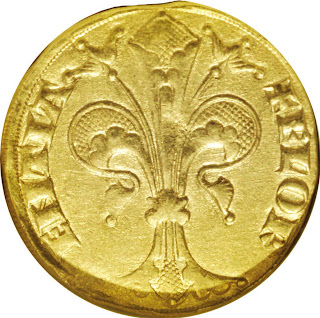Heads or Kales? Bring back the floral Florin
James Joyce mentions the florin early into Ulysses, reason enough for Frank Delaney to tell us about the origin of the word in his exasperatingly brilliant Re:Joyce podcast.
The 'florin' was first used and named in the Italian city of Florence, or Firenze, but according to Delaney the name refers to a flower rather than the city. The first coins, he says, bore a lily on one side.
The name of the Italian city has nothing to do with flowers. It was originally called Fluentia because it was built between two rivers and the name evolved from there. (Coincidentally, the name Entwisle probably comes from an Old English or Norse word for the piece of land between two rivers, a twisle or twisla; the 'Ent' bit may be from the word for water hen, enna or henn, an animal no doubt frequenting such areas.)
Not everyone takes the side of the flower over the city. My old literary companion Dr Samuel Johnson, for example, cites William Camden's view that the Florin was so named because it was made by Floretines (which I take to be the inhabitants of the Italian city rather than tasty biscuits).
I prefer, of course, the botanical derivation. The original coin certainly seems to have been adorned with a flower on one side. In this line of thinking, Florin comes from Fiorino, the diminutive of flore (or in Latin flos and flor) - that is, a small flower.
The link to the city may be in the identity of the flower which, according to the Oxford Dictionary was the Fleur-de-lis (a stylised lily flower), the emblem of the city Florence.
The Florin has been used in various currencies since the thirteenth century, such as the Dutch guilder and the English two shillings (although Johnson oddly says it is a coin of Edward III and worth six shillings).
Australia didn't quite get it, using the tail side of the coin to display the country's coat of arms. Luckily that coat includes a sprig of Golden Wattle, Acacia pycnantha, clearly visible on this particular coin.
But of course the Florin has gone the way of the penny and pound. Today, what flora appears on our coins and notes? We have plenty of wildlife - an echidna on our five cent coin, a lyre bird on the ten, a platypus on the twenty, kangaroos on the dollar, some cows and horses (and humans) on the $10 bill, a camel and humans on the $20, horses and humans on the $100, and only humans on the $2 coin* and $50 note.
The 50 cent coin has something behind the shield component of the coat of arms that might be vegetable matter - certainly not clearly identifiable as wattle - but it's the two Australian animals that dominate.
The $5 bill is where we chose to celebrate the Australian flora, at least a little, with a eucalypt branch reaching out to the shoulder of Queen Elizabeth II like Adam to God on the ceiling of the Sistine Chapel.
So bring back the florin I say. Or at least wrap the playpus in some algae or something photosynthetic. Better still, lets put a cabbage on the 20c coin so we can call "heads or kales".
Images: my pictures today are from a web trawl and seem to be in common use...
* Todd McLay left a comment pointing out, quite rightly, that there is definitely a small Xanthorrhoea (Grass Tree) on the $2 coin. Well spotted!


.jpg)


Comments
Tim